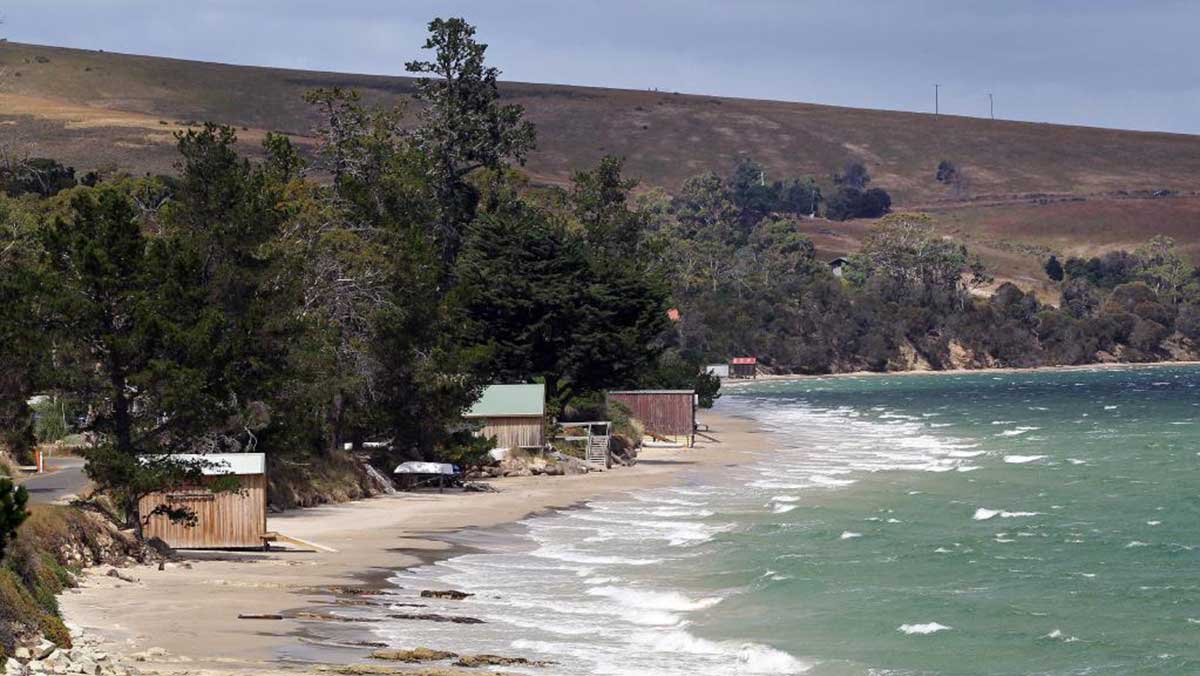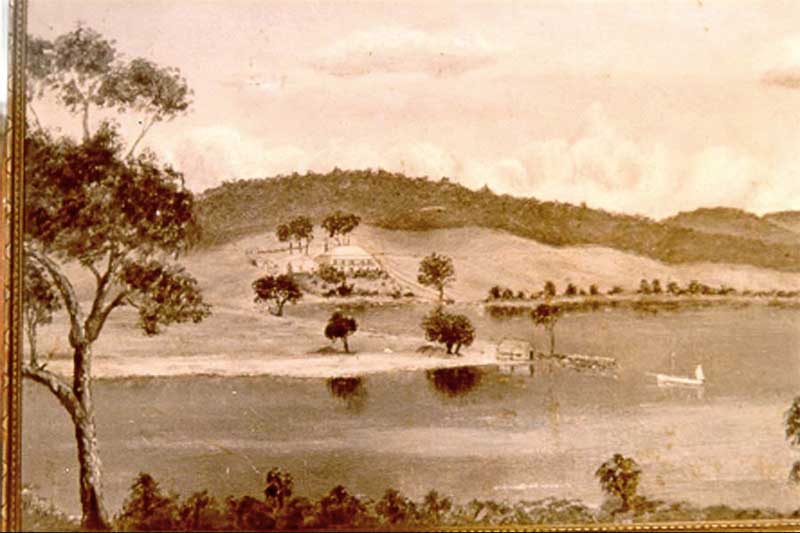Variety Bay, Bruny Island, Tasmania

The Variety Bay area on the east coast of North Bruny Island contains a number of important archaeological sites dating back to Tasmania’s early settlement period. It includes the remains of an 1830s pilot station, an early brickworks, and the ruin of one of the earliest Anglican churches in southern Tasmania. The pilot station, one of Tasmania’s oldest, is an important site in the course of Tasmania’s settlement history, because of its role in regulating the shipping traffic into Hobart from 1831-1854.
The pilot station was established at Variety Bay on North Bruny Island from 1831. This was set up with the extensive aid of convict labour. Remains can still be seen at the site today and include the foundations of three recognizable buildings, bakers oven, rock and brick lined cellar and a rock walled watch tower. The brickworks was a key site in the development of local industries and communities on Bruny Island.
The Variety Bay Historic Sites also contain Aboriginal heritage places that are possibly of National Estate significance.
Permanent European settlement of the island began in 1818 when Captain James Kelly was granted land on North Bruny. Shore based whaling stations were established in the 1820s.
In 1830 William Lawrence applied for a 320 acre land grant at Variety Bay in order to establish the island’s first pilot station. The station was completed in 1831 and Lawrence became the official pilot, responsible for guiding ships into the mouth of the Derwent River and safe anchorage at Hobart. Locating the station in Variety Bay gave lookouts a wide view of sea traffic approaching Hobart via Storm Bay and the mouth of the Derwent River. Pilots from the station would board the ships and guide them into port.
The Variety Bay pilot station soon became an important link in the water traffic in and out of southern Tasmania. During its time of operation, from 1831-1854, it had upwards of a few hundred employees and convict labourers working on site. The pilot station complex was destroyed by fire in the 1850s, and was not rebuilt. However, the extensive archaeological remains that exist there have been left largely untouched since.

Variety Bay Pilot Station
Among the main features today are the brick foundations of the main structure, the ruin of a circular rock-walled watch tower, now standing only approximately 1.5 metres in height, a brick lined cellar and a brick baker’s oven. The foundations of the convict quarters, foundations of a stable and a number of stone/brick landscape features are also evident. Remnants of the garden, featuring flowering bulbs and oats, can also be found within close proximity to the main building’s foundations.
The Variety Bay Pilot Station is one of the oldest pilot stations in Tasmania, the oldest of these is thought to be the Low Head Pilot Station, at George Town near Launceston, which was first established in 1805. The extant stone buildings at Low Head were constructed in 1835 and are therefore contemporary with the Variety Bay ruins. The Low Head buildings, however, remain standing and are currently part of a Museum complex. Nonetheless, the Variety Bay Pilot Station is still important for its archaeological potential and for its contribution to the building of the port of Hobart.
Variety Bay Brickworks Site
The site of the old brick works lies several hundred metres to the south of the pilot station. Bricks manufactured here may have been used to construct the pilot station, meaning the brick works could pre-date 1831. Bricks were probably manufactured using convict labour. Up until the early 1950s there were still thousands of bricks on site. In 1954, the Bligh Museum of Pacific Exploration was erected at Adventure Bay. Some 26,000 bricks were taken from the brick works site to construct this building.
The remains of the Variety Bay brickworks are quite substantial, featuring the ruin of a large kiln and associated clay pit. The kiln remains are surrounded by clay and stone rubble, which was used to insulate the kilns. In 1954 Len Mitchell and John Davis were among a group of mates that dismantled the Variety Bay kilns with their load of bricks that had remained untouched since they were fired, around the 1830s – 1840s. Some 26,000 bricks were taken from the brick works site and removed to Adventure Bay where the Bligh Museum of Pacific Exploration was constructed – to the design of St Peter’s.
While the site was probably disturbed during the removal of the 26,000 bricks in the 1950s, the kiln site itself is relatively undisturbed, and may have archaeological potential. The Variety Bay site is a relatively unusual example of an early Tasmanian convict brickworks, and was probably instrumental in the establishment of various European communities on Bruny Island.

St Peters Church
St Peters Church (1846) was built in the vicinity of the pilot station, also using convict labour. This was the first Anglican Church built south of Hobart. The church is now a ruin. The St Peter’s church ruin is an important community icon, being one of the earliest Anglican churches in the wider region, associated with the development of the Anglican faith on Bruny Island and the wider region. It is also associated with the man who designed and consecrated it, Russell Nixon, the first Anglican Bishop of Tasmania. The St. Peters Church was a gable roofed brick building with brick corbelling to the eaves. The building no longer has a roof and the walls have been braced to protect them from falling.
The church was constructed by Lawrence (the pilot) in 1846, to the design of Russell Nixon, the first Anglican Bishop of Tasmania. Bishop Nixon laid the foundation stone in 1841 and the church was officially opened in 1847 by Archdeacon Marriott, with Nixon consecrating it in 1850. At the time of its construction, St Peter’s at Variety Bay was one of the few existing church buildings south of Hobart. In the 1850-1890 period it served as a base for the Anglican community from Bruny Island and the adjacent D’Entrecasteaux Channel coast. In 1892 a large portion of the church, including the roof, was damaged in a bushfire. Some of the original pews were salvaged and removed to a church in North Bruny Island.
St Peter’s was constructed on the crest of a hill, allowing it to be seen from a great distance away. There is also evidence that its yard was used as an early cemetery. Three unmarked graves have been located (and have since been outlined with bricks), although the identity of those buried there is unknown. Local oral history suggests that in previous times five wooden crosses, representing the graves of five ticket-of-leave men, were visible within a large yard surrounded by a picket fence.
The Bruny Island Historical Society has invested large amounts of time and effort in protecting and curating the sites, and raising funds for ongoing conservation works. They have also worked very closely with the current owners, who are highly supportive of efforts to safeguard the sites. Wider community attachment to the site can be demonstrated in the number of donations received from local organisations towards conservation efforts.
Individually, these features provide valuable evidence of particular activities that were once important, both in the immediate vicinity and the wider Bruny Island region. The pilot station, being instrumental in the guidance of shipping into Hobart, represents an important phase in the early development of Tasmania as an independent colony. Together, the features form an informative and interesting record of early life on Bruny Island.
